What a 40% year taught us: 4 lessons from the past 12 months (and 3 new stocks to buy)
This time last year, my co-PM Ben Richards and I wrote this piece on Livewire, reflecting on the lessons learned in the first 12 months of running the Seneca Australian Small Companies Fund. The feedback was (mainly) positive, so we’ve decided to run it back with another candid review, this time of year 2.
However, for us, performance is only part of the story. What matters just as much is how we get there. Critically reviewing our decisions — the good, the bad, and the in-between — helps us identify biases and blind spots, while reinforcing the disciplines that drive long-term outperformance.
“You do not rise to the level of your goals. You fall to the level of your systems.” – James Clear
With that in mind, what follows are four lessons from the past 12 months, each illustrated by a real case study from our portfolio. For every lesson learned, we’ll also share a new investment idea where we’re putting those insights into action for the year ahead.
Lesson 1: Spotting Takeover Targets Isn’t Luck — It’s Process
Twelve months ago, we had a hunch that our approach to stock selection might naturally identify takeover candidates. After this year, we no longer think it’s just a hunch — it’s a pattern.
Over the past year, several of our holdings received takeover offers:
- RPMGlobal (ASX: RUL): 32.6% premium to last close
- Infomedia (ASX: IFM): 30% premium to last close
- PointsBet (ASX: PBH): 28% premium to last close (and a bidding war pushed this higher again.)
- Alongside rumoured or partially confirmed interest in Emeco (ASX: EHL) and Euroz Hartleys (ASX: EZL).
Importantly, our thesis is never solely based on the expectation of receiving a takeover bid. Instead, we focus on businesses with undervalued assets, strategic optionality, and high-quality, often improving, fundamentals. When you find that combination, it’s no surprise that others — whether strategic buyers or financial sponsors — eventually come to the same conclusion.
We’ve written previously on Livewire about how we think through takeover potential, and perhaps the clearest case study this year was our high-conviction holding in RPM Global (RUL), a world-leading mining software provider.
Our thesis was straightforward:
- RPM was compounding revenue at >20% p.a., with profitability inflecting upwards.
- Reported earnings understated reality, as the company expensed software development (rather than capitalising it, like most peers).
- The transition to a subscription model created higher-quality, recurring revenue streams.
That thesis was playing out well. Just before its takeover offer, RUL announced:
- Subscription revenue up 20% to $54.8m
- ~$200m in contracted future revenue
- FY26 EBITDA guidance of $23–25m, comfortably above consensus.
Valuation had looked fully priced in recent months, with shares rarely holding above $3.30. However, when the company sold its advisory division in February, the takeover probability rose significantly. Management’s strong track record of selling businesses to trade buyers gave us further conviction — so we opportunistically increased our position.
On 29 August, RUL entered a trading halt. Days later, Caterpillar (NYSE: CAT) lobbed a non-binding cash bid of $5.00 per share.
Just as with RPMGlobal, we believe the market is overlooking another strategically valuable business — a company that doesn’t screen well today, but whose cash generation and regulatory tailwinds could make it the next standout opportunity.
Next Idea: Eroad Limited (ASX: ERD) — From Hero to Zero, and Back Again
If RPMGlobal showed us how undervalued strategic assets attract acquirers, then Eroad (ASX: ERD) is our next opportunity to apply that lesson. The fleet telematics provider has fallen from grace in recent years, but beneath the noise, we see a business entering a powerful free cash flow inflection, with regulatory tailwinds that the market has yet to price in.
Why It Doesn’t Screen Well (Yet)
- ERD has looked messy over the past three years due to a $30m hardware replacement program, forced by the global 2G/3G shutdown.
- Those costs obscured the business's true profitability, but they are one-off in nature and will roll off by the end of CY2025.
- As this noise clears, mainstream investors will see a business generating robust free cash flow from a 95% SaaS revenue base with sticky, recurring customers.
Quality Is Improving
- Free cash flow inflection began in FY25; we believe this is just the start.
- Focus has shifted to higher-value enterprise clients, while smaller, less profitable customers are being allowed to churn.
- Operating leverage is building: Australia has reached critical mass with 20%+ growth, supported by NZ customers expanding fleets into Australia (e.g. Mainfreight, Linfox, Fonterra).
- New Zealand margins are already market-leading (~50% EBITDA). As group scale improves, blended margins should trend in that direction.
- Stronger cash generation has enabled deleveraging, with the company moving to a net cash position.
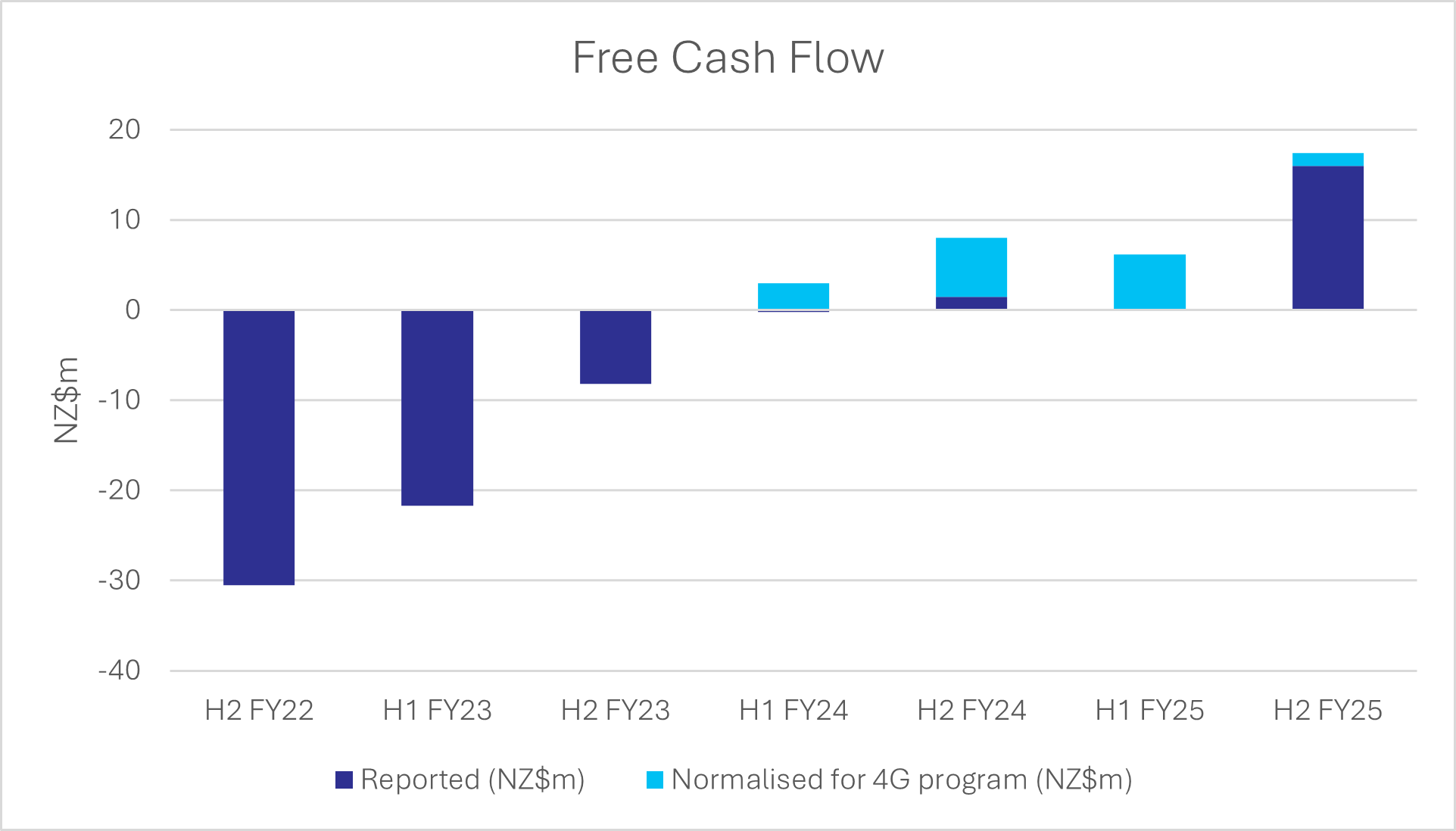
The Next Leg of Growth: eRUC Expansion
Eroad dominates New Zealand’s electronic Road User Charging (eRUC) system, holding ~92% market share of heavy vehicle licences.
In August, the NZ government announced all vehicles will transition to eRUC by 2027 — a seismic policy shift. This adds ~3.5m vehicles to the ~1m currently charged, creating an incremental revenue opportunity of ~$150m at elevated gross margins.
Even at a 30% market share, ERD could add ~$30m EBIT by FY28. On a conservative 15x multiple, this alone underpins a valuation well north of A$3.50. Longer term, we see the same regulatory shift spreading into Australia and the US as EV adoption forces governments to rethink road funding.
Valuation: Mispriced and Misunderstood
- Current multiples: 2.2x EV/Sales, 7.2x EV/EBITDA, ~21x FY27e free cash flow.
- Peers: Telematics player Samsara (NYSE: IOT) trades on ~11x EV/Sales; pre-COVID, ERD itself averaged 3.4x on the NZX.
- Upside: A re-rate to just 3.5x EV/Sales implies at least 50% share price upside to $3.50.
- Optionality: If the market becomes convinced by profitable growth and regulatory tailwinds, a >5x Sales multiple is not unrealistic.
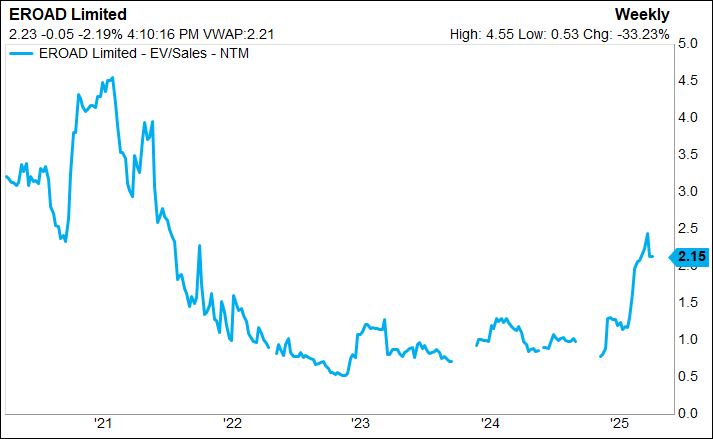
Eroad is emerging from a difficult chapter with stronger unit economics, regulatory catalysts, and strategic value. It’s precisely the type of underappreciated asset we seek: one that screens poorly now, but could re-rate sharply as cash generation and growth become visible. We think ERD is at least a 50% upside story — with potential for much more if the market recognises its SaaS-like profile.
Lesson 2: Know When Valuation Doesn’t Matter (Yet!)
When I first started out on a stockbroking desk, an older broker gave me advice:
“Never forget how early you are.”
What he meant was simple: appreciate the privilege of spending six hours a day immersed in markets, meeting management teams, hearing from economists, and having fingertip access to almost every piece of publicly available information. That perspective is an advantage — and one we aim never to waste.
In small caps, inefficiencies abound. But when you’ve already made good money on a stock, it can be tempting to think the easy gains are gone. As one less insightful broker once told me: “You never go broke taking a profit". True enough — but this will result in selling too early, and early investors often miss the fastest and most violent phase of share price appreciation. I suppose it's one of those 'curse of competence' scenarios.
This dynamic played out for us during the year in stocks like RPM Global (ASX: RUL), Catapult (ASX: CAT), and Energy One (ASX: EOL). Many peers sold into strength on valuation grounds, arguing these businesses looked expensive. But valuation is rarely the primary driver of returns. At certain stages, other forces — index inclusion, broker upgrades, short covering, or even takeover interest — matter more. Recognising which driver matters most today is key.
The Software Playbook
We’ve seen the same re-rating journey across several software names, and it's helped us to make the most of our successful early investments
Phase 1 (~2x EV/Sales): Speculative growth, no profit.
Phase 2 (3–5x EV/Sales): Growth potential, no profits yet.
Phase 3 (~7x EV/Sales): Accelerating, sustainable profits (Rule of 40)
Phase 4 (10x+ EV/Sales): Near-infinite growth of >20% p.a.
Catapult (ASX: CAT) is a near-perfect case study. Once dismissed as an unprofitable “dog,” it’s now been accelerated by index inclusion: the S&P/ASX All Technology Index (Sep 2024), ASX300 (Mar 2025), and now the ASX200 (Sep 2025, via the Gold Road takeover).
With so few quality software names on the ASX, businesses that can deliver sustainable growth command a valuation premium.
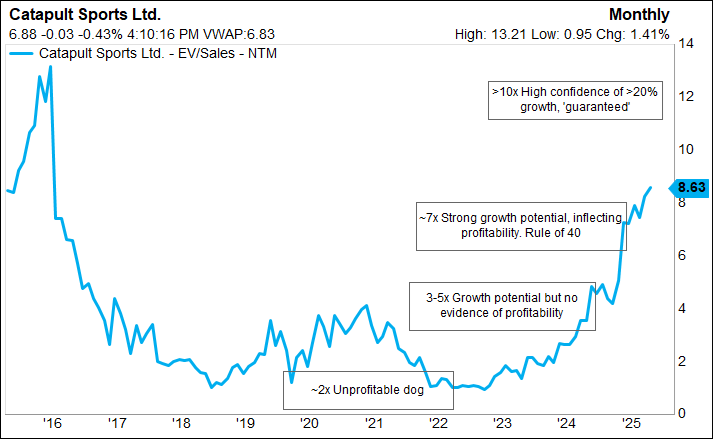
The same “sweet spot” dynamic is playing out in Energy One (ASX: EOL), which has grown into a $550m market cap business. Its trajectory has been so compelling that we see genuine potential for the elusive 10-bagger from our $5.33 average entry price. It has followed a similar playbook to Catapult.
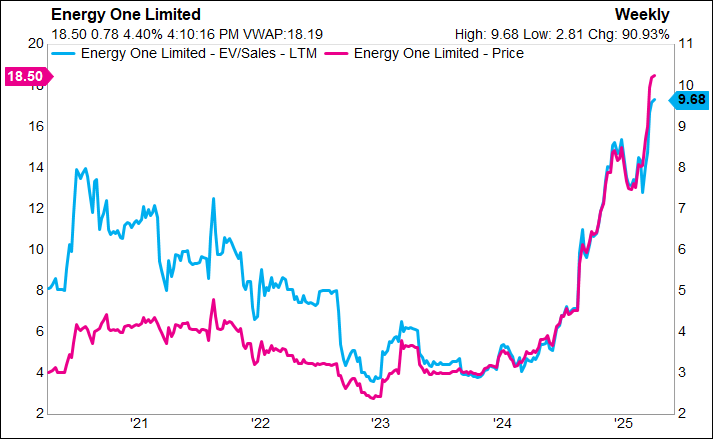
Next in the Sweet Spot: Qoria (ASX: QOR)
We’ve spoken before (here and here) about Qoria (ASX: QOR), the kids’ cyber-safety software provider. With strong sales growth, profitability inflecting, Rule of 40 metrics lining up, and potential index inclusion ahead, we believe QOR is on track for $1.00+. The ingredients are familiar — and the market discovery curve looks set to repeat.
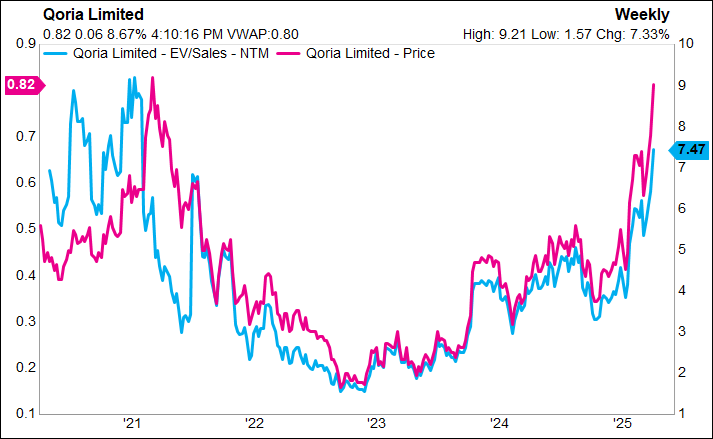
Lesson 3: Running a Business Helps You Run a Portfolio
Markets often overreact to short-term noise. Separating what matters — the fundamental drivers of a company’s earnings and share price — from what doesn’t is fundamental to making money in small caps.
As business owners ourselves, we know no company grows in a straight line. Sometimes a quarter or a half-year looks weak for entirely normal reasons: timing of orders, inventory cycles, or one-off impacts. Recognising this distinction is where we believe Seneca has an edge over many managers who have never had to run a business themselves.
Case Study: XRF Scientific (ASX: XRF) misses March earnings forecast
We increased our position in XRF Scientific (ASX: XRF) around $1.50 after a sell-off on the back of its March quarterly results.
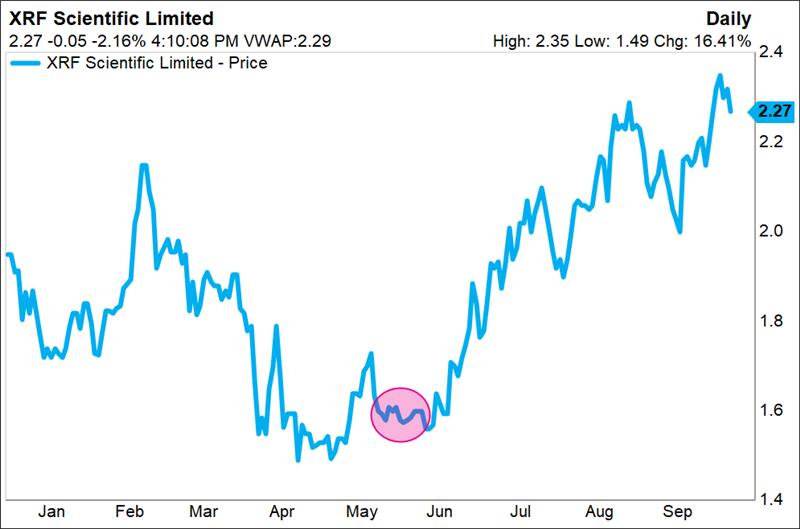
We discussed our thoughts in detail here, but to us, this was normal operating volatility — and an opportunity to buy more of a high-quality business at a cheaper price.
Understanding the weakness in the XRF share price was straightforward once you broke the business down into its three divisions:
- Capital Equipment (testing instruments), where order timing creates natural lumpiness — revenue can swing depending on whether a sale lands on one side of a reporting period. This volatility on a period-to-period basis doesn’t change the long-term trajectory of the business, but can impact the share price short term.
- Precious metals (testing componentry) are the pseudo-recurring revenue streams from recycling labware exposed to high temperatures.
- Consumables (chemicals sold to labs and miners) are the recurring, sticky revenue streams associated with lithium-based products. Revenue moves with the lithium price, but costs are passed through to customers, keeping margins stable. This relationship means the underlying business growth can remain solid even when headline revenue appears flat.

The key takeaway is that broker estimates and market sentiment towards earnings are far more volatile than the business's actual earnings, due to this lack of nuance. That disconnect in understanding is where patient capital gets paid.
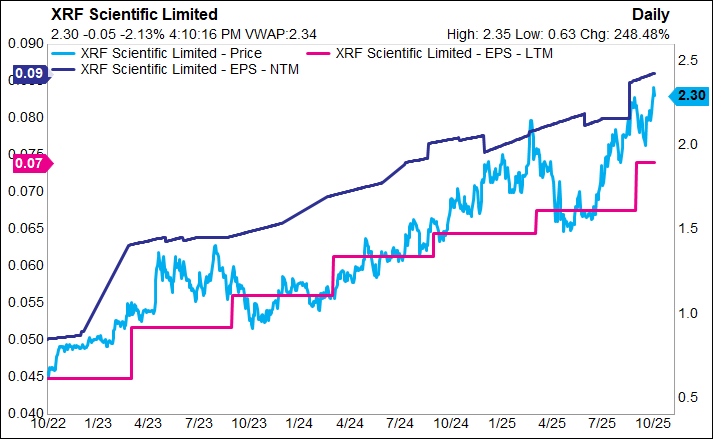
Business owners understand the natural rhythms of growth better than most - quarters that look soft, followed by periods of catch-up, all while the long-term fundamentals continue to compound. Many managers — especially those who’ve only ever collected a salary — mistake noise for signal and, as a result, open up opportunities to extract excess returns.
The next idea: Regal Partners (ASX: RPL) - flows matter more than front page headlines
On March 25, the front page of the Australian Financial Review read "Clinical trial flop rattles Regal Investors".
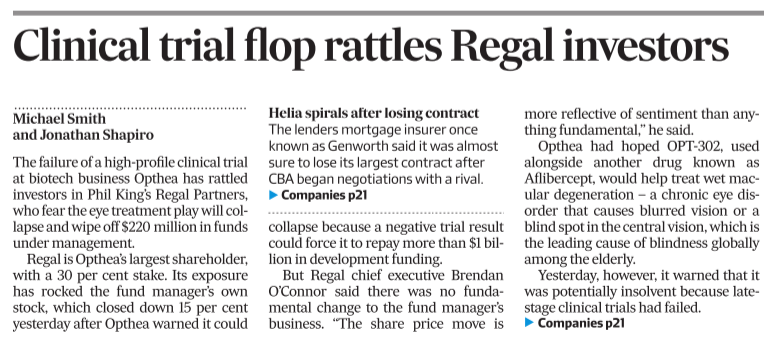
The RPL share price tanked, falling from ~$4.00 to lows of $1.62.
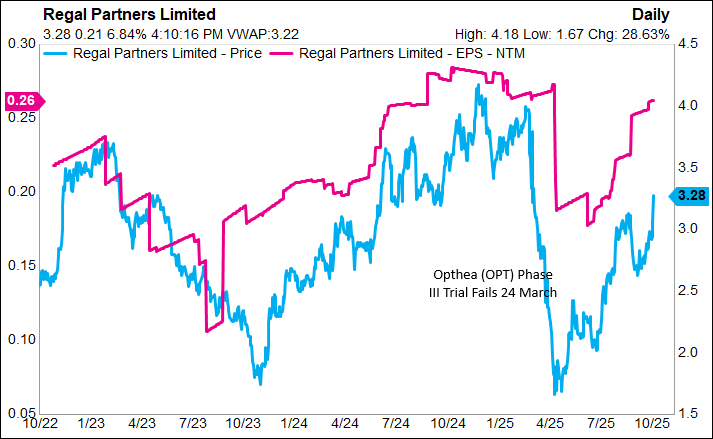
While the stock piqued our interest at the time, we weren't sure of the extent of the reputational damage and just how much these poor investment decisions would hurt underlying funds under management.
However, the half-year result in August allayed many of our concerns, the key points being:
- $300m in inflows in July 2025
- $1.9bn in net inflows over the 12 months (up 120% pcp)
- 66% of FUM above or within striking distance of its high-water mark (i.e. performance fee eligible), which has increased to 78% over the subsequent 2 months
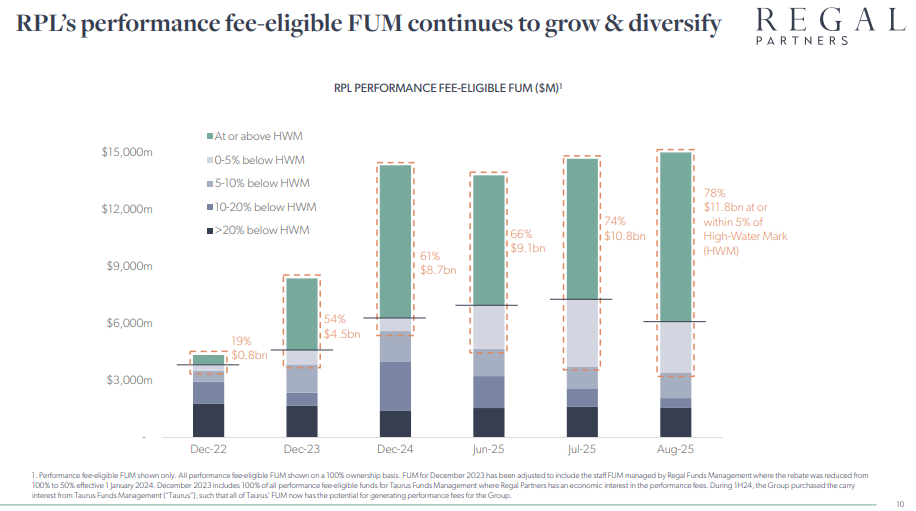
With the stock trading at below-average valuations on suppressed consensus estimates and near an all-time low relative valuation to main peer Pinnacle (ASX: PNI), it was (and remains!) a compelling opportunity in August.
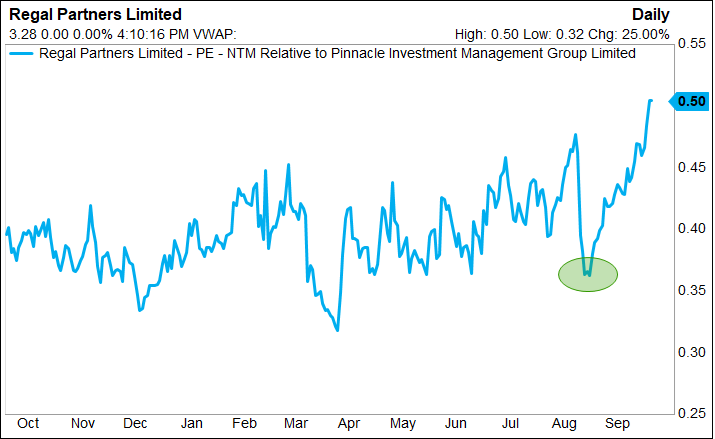
We think Regal's is focusing on all the right asset classes. Royalties. Water Rights. Australian Small Caps. It's very much aligned with what we are doing in our portfolio. We own:
- Red Hill Minerals, ASX: RHI, for its royalty exposure to the Mineral Resources (ASX: MIN) Onslow expansion;
- Water investment specialists Duxton Water (ASX: D2O);
- And as mentioned at the top, we are backing ourselves to generate high returns for investors in our Seneca Australian Small Companies Fund with a 0.00% management fee.
Lesson 4: Picking stocks is more than just financial modelling
In our opinion, anyone who starts a stock pitch with a spreadsheet is missing the point.
Financial models matter, but they’re only as useful as the assumptions behind them. Too often we see companies that look cheap “on paper,” with numbers modelled to within an inch of their life — but the model itself is focusing on the wrong driver.
Understanding how businesses actually work is just as important as crunching numbers. You need context: the business model, the incentives of management and the competitive environment. Numbers without that context are dangerous — they give a false sense of precision.
Case Study: Botanix PHARMACEUTICALS (ASX: BOT)
We lost money on Botanix (ASX: BOT), but avoided far worse damage by trusting our instincts.
On paper, BOT looked cheap. But management’s behaviour told a different story. If cash flow was truly inflecting, why issue a large block of stock? And why allocate capital to expanding the sales team before proving sales traction? To us, the incentives didn’t add up.
We didn’t sell immediately — instead, we exited after the post-placement rally. The raise was heavily oversubscribed, and there was strong on-market support, but the fundamentals still didn’t make sense. By respecting the “soft side” — management decisions and incentive structures — rather than relying solely on the model, we minimised losses and moved on.
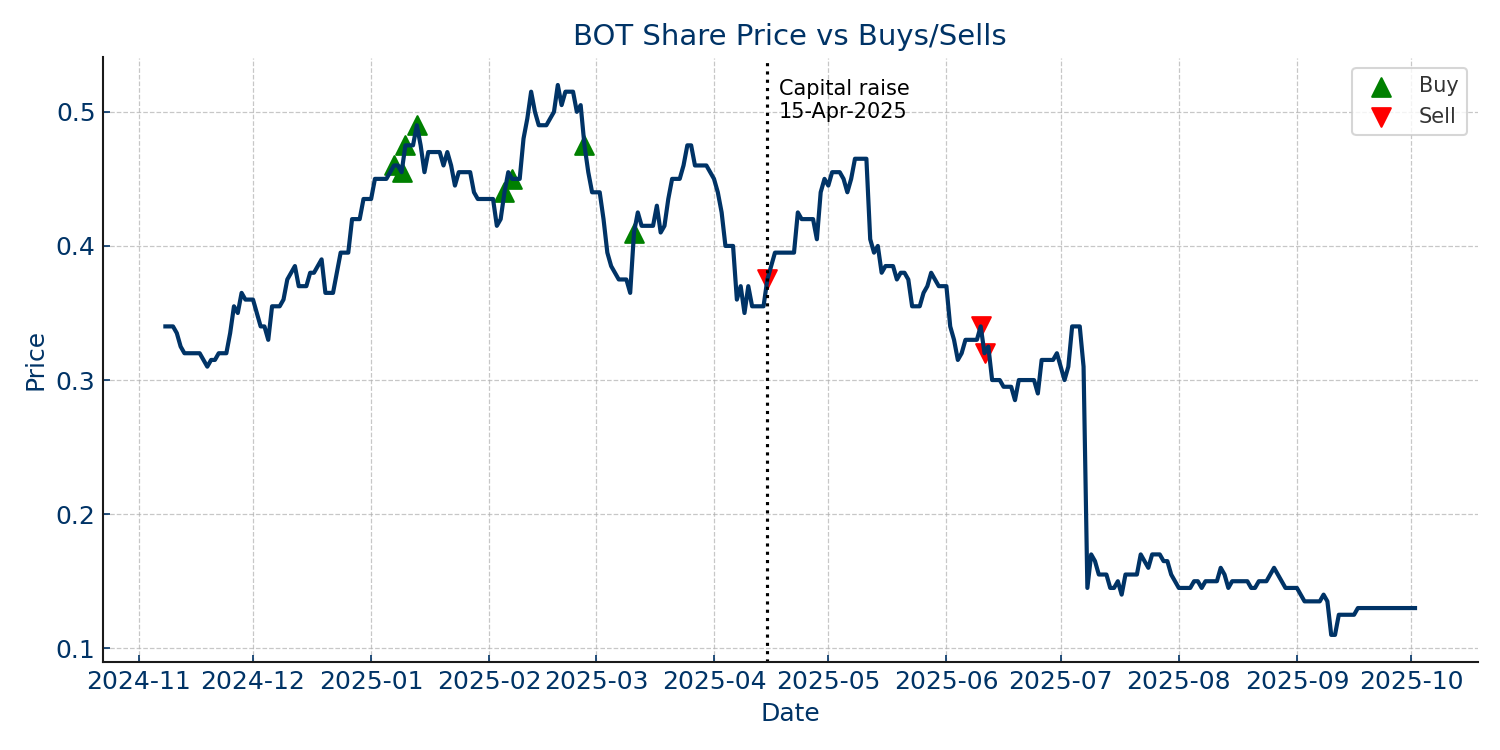
Numbers can only tell you so much. What really moves stock prices is often outside the spreadsheet: management behaviour, capital allocation decisions and incentives. Trusting instincts, shaped by experience, can save you from expensive mistakes.
Case Study: GQG Partners (ASX: GQG)
It was the same instincts that allowed us to avoid a loss in GQG Partners (ASX: GQG). As trailing returns in their flagship Global Equity strategy started to lag their benchmark, we were alert to the rising risk of a period of net outflows. However, a random and rare invitation to a webinar with the portfolio manager hit my inbox on the morning of 22 July and triggered my intuition—an out-of-cycle webinar screams an attempt to stem redemption requests.
While we usually base our decisions on hard data, this time, we had no concrete evidence to support our decision and acted on our instinct. We were able to exit the position successfully at $2.22 on 22 July, before the first negative monthly outflow was announced to the ASX on 8 August, and the stock fell from $2.12 to a post-announcement low of $1.65.
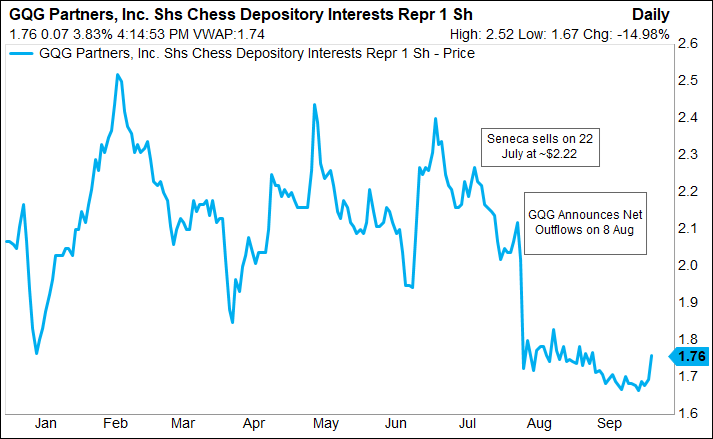
Our performance
The 12 months to 30 September were exceptional.
Our fund returned 39.16% after fees for the 12 months to 30 September 2025, outperforming the S&P/ASX Small Ordinaries Index by +17.66% — placing us among the top handful of Australian equity fund managers.
Since inception, we’ve delivered 33.59% p.a. after fees, beating the benchmark by +13.45% p.a.
Our fee structure remains straightforward and aligned: 0.00% management fee, with a 20% performance fee above the RBA Cash Rate, subject to a high watermark.
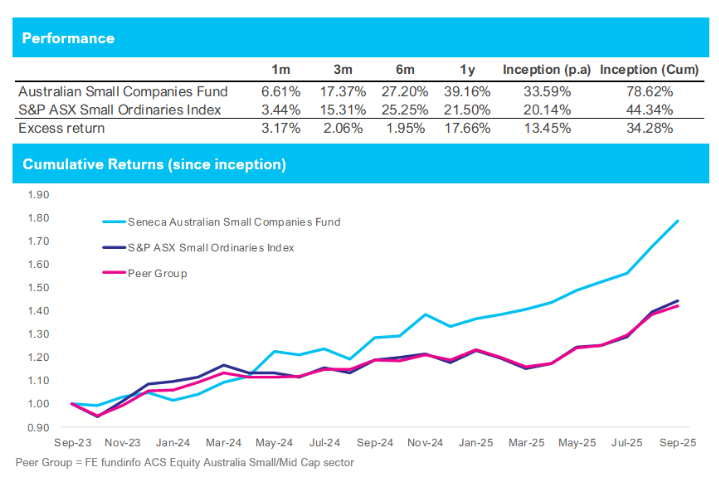
Summary
Ben Richards and I continue to work hard each day, turning over all the rocks and (mostly) enjoying the opportunity to get paid to learn about interesting (and often inspiring) businesses and business owners. We are very appreciative of the people who enable us to do this job and have invested their hard-earned money, alongside our own. We are happy they've been rewarded with another strong 12 months of returns and look forward to building on that for many years to come.
The Seneca Australian Small Companies fund is open to qualified sophisticated, professional, and wholesale investors. Minimum initial application is $100,000 via the fund administrator's website (linked here). We accept applications monthly.
If you'd like to receive our regular updates, you can sign up for our distribution list here.
If you're interested in investing with us or would like us to manage your portfolio, use this link to book a chat with me.
5 topics
17 stocks mentioned
1 fund mentioned
1 contributor mentioned

